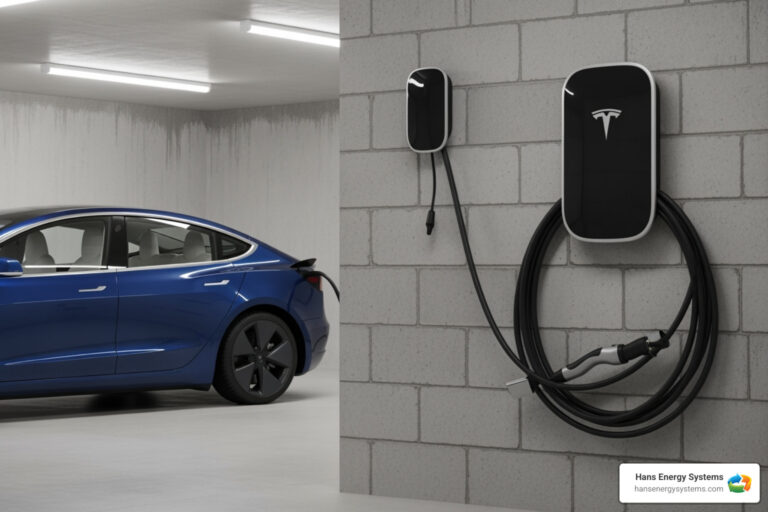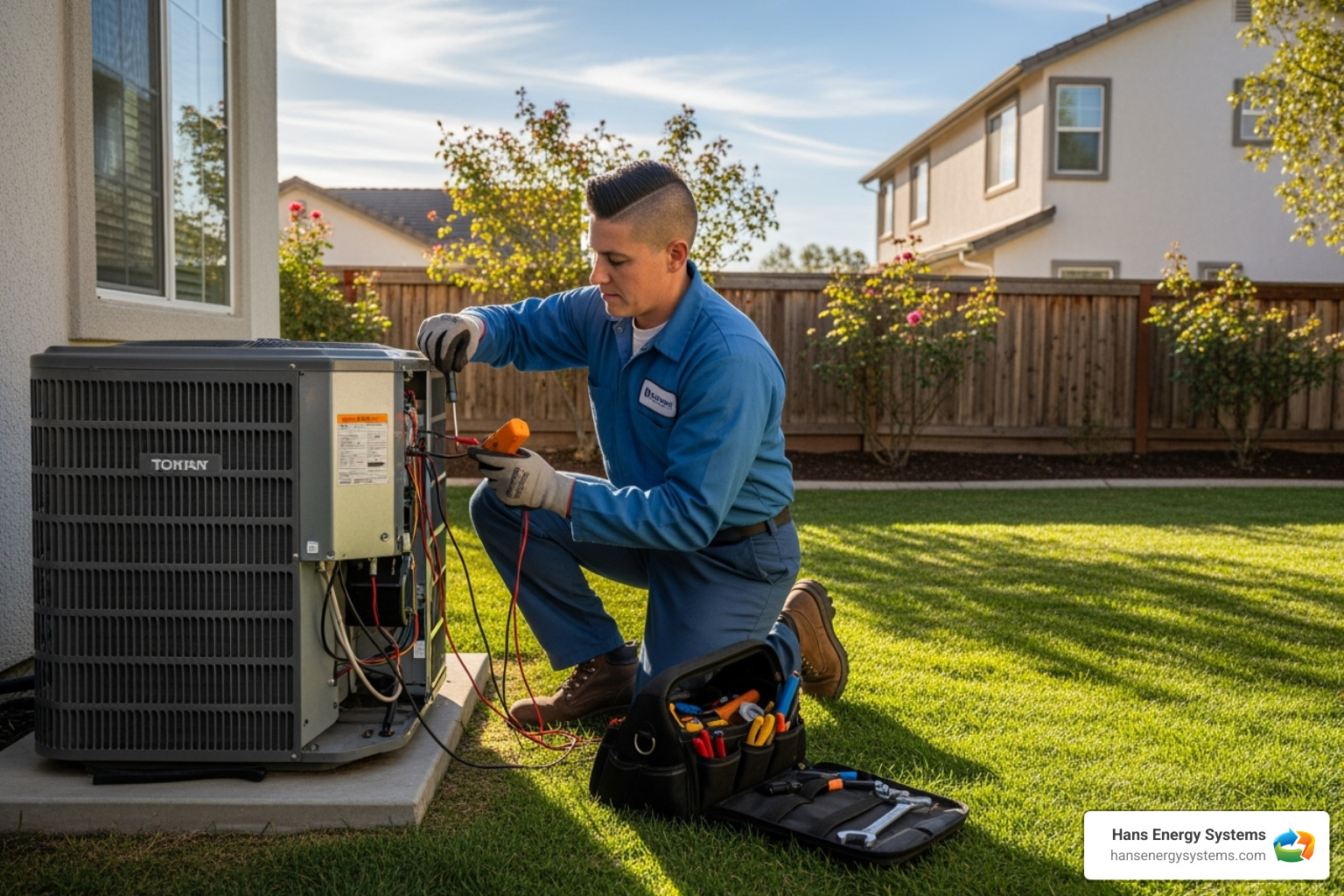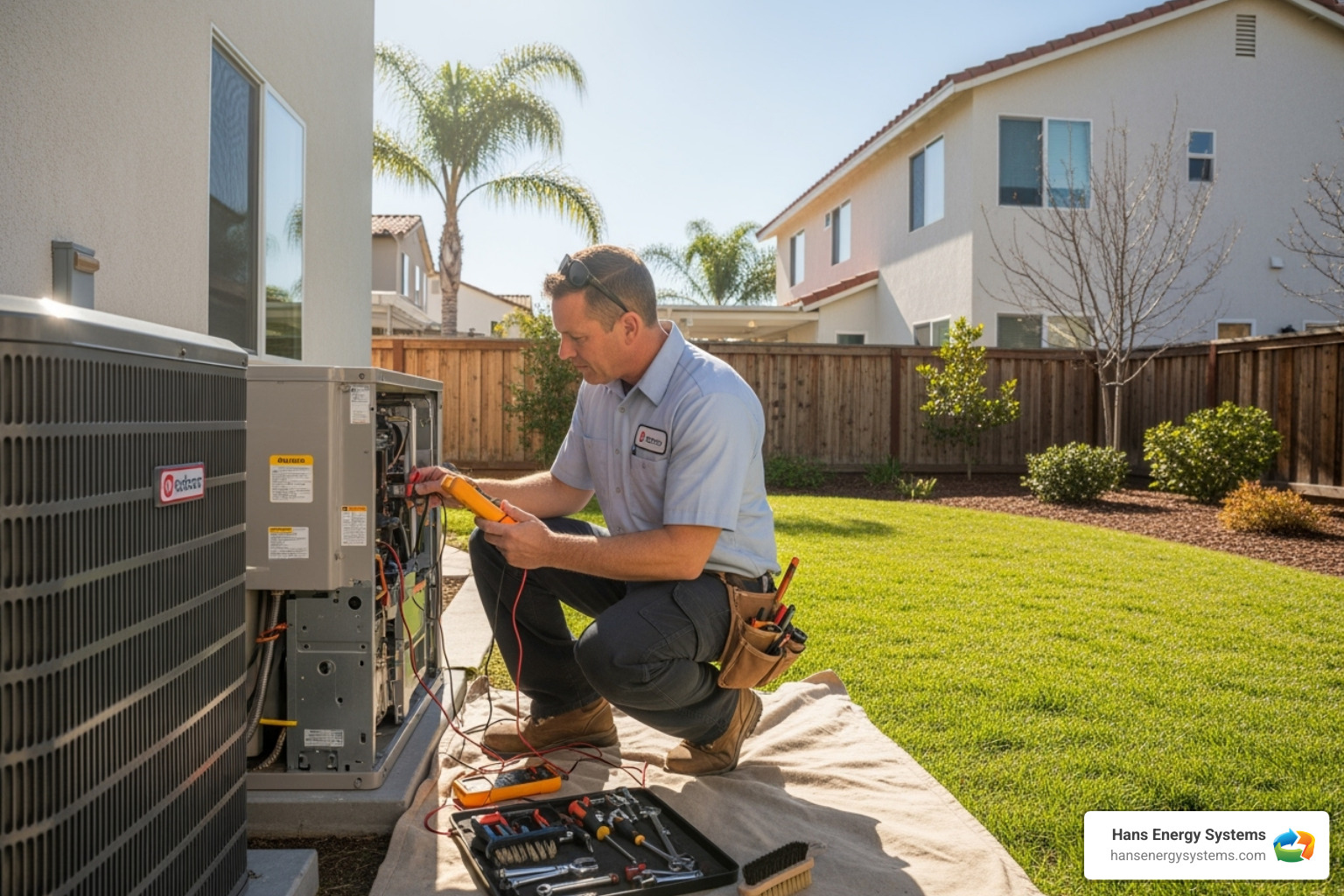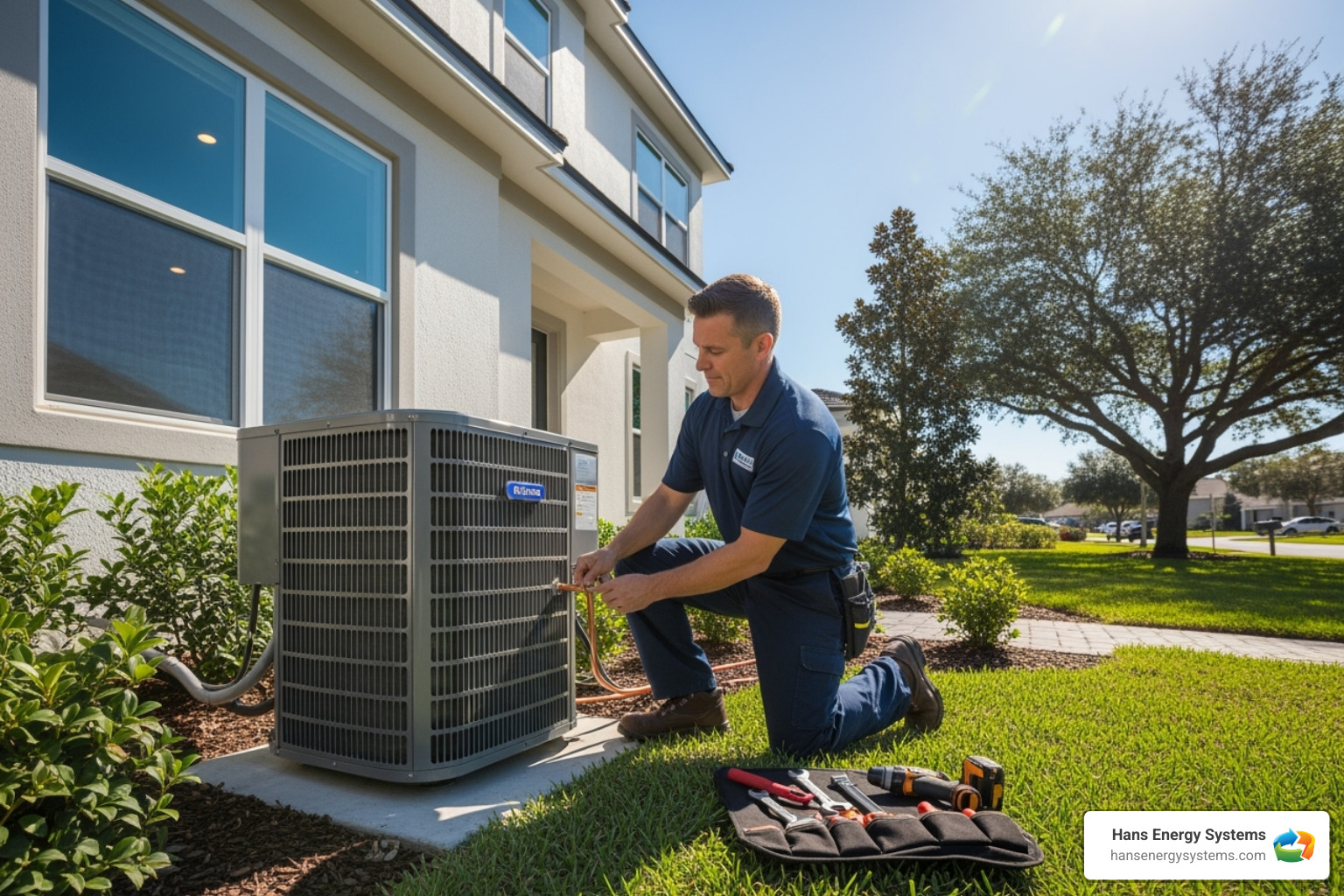Why Tesla Owners Choose Wall Mount Chargers
A wall mount tesla charger offers owners the fastest, most convenient home charging solution. Unlike the mobile connector that uses standard outlets, the Tesla Wall Connector delivers up to 44 miles of range per hour and integrates with your Tesla app for smart scheduling and monitoring.
Key benefits of a wall mount Tesla charger:
- Fastest home charging – Up to 11.5 kW (48 amps) output
- Smart features – Wi-Fi connectivity, app control, and automatic updates
- Convenience – 24-foot cable with auto-sensing handle
- Durability – Indoor/outdoor rated with 4-year residential warranty
- Power management – Can share power between multiple chargers
For Southern California homeowners dealing with high electricity costs, a wall-mounted Tesla charger paired with solar panels can significantly reduce charging expenses. The Wall Connector’s scheduling features let you charge during off-peak hours when rates are lowest.
Installation requires a qualified electrician, as it may involve upgrading your electrical panel to handle the higher amperage. Finding a professional is straightforward, with over 1,400 Tesla Certified Installers across North America.

What is the Tesla Wall Connector?
The Tesla Wall Connector is Tesla’s dedicated Level 2 home charging solution, a sophisticated device designed for seamless integration into your daily routine. The Wall Connector is the gold standard for a wall mount tesla charger, known for its robust features and reliable performance.
Its sleek design hides powerful capabilities. The Wall Connector delivers Level 2 charging using a 240-volt circuit, which is significantly faster than standard 120-volt outlets. This allows for rapid overnight charging, ensuring your Tesla is ready each morning.
One of its standout features is Wi-Fi connectivity, which allows the charger to receive over-the-air (OTA) updates. This means your charger continuously improves, gaining new features and functionalities over time without manual intervention.
Its 24-foot cable provides ample reach whether you park in the garage or driveway, and its auto-sensing handle makes plugging in easy. The unit is versatile and suitable for indoor or outdoor installation, adapting to nearly any home.
For those looking to improve their Tesla charging experience, we highly recommend exploring the Tesla Wall Connector. You can learn more and acquire this essential home charging device directly from the source: Order Wall Connector.
Standard vs. Universal Wall Connector
When considering a Tesla Wall Connector, you’ll find two main versions: Standard and Universal. Their primary difference is compatibility with various electric vehicles.
The Standard Wall Connector is designed for Tesla vehicles. It comes with Tesla’s proprietary charging connector, making it ideal for owners who only charge Tesla vehicles.
The Universal Wall Connector is a game-changer for multi-EV households. It has the same performance as the Standard but includes an integrated J1772 adapter for non-Tesla EVs, alongside the NACS plug for Teslas. The J1772 connector is the standard for most other EVs in North America. This makes it a versatile, future-proof solution for charging any EV without separate adapters.
For a charging solution that caters to all electric vehicles, the Universal Wall Connector is an excellent choice: Order Universal Wall Connector.
Smart Features and App Integration
Beyond its charging capabilities, the Tesla Wall Connector shines with its smart features and app integration. This connectivity creates an intelligent, controllable charging experience.
Once connected to your home Wi-Fi, you can register the Wall Connector in your Tesla app. This open ups features that put you in control. You can view charging stats and history to track energy consumption and manage costs, especially on time-of-use (TOU) electricity plans.
One of the most appreciated features is scheduled charging. You can program your Wall Connector to charge during off-peak hours when electricity rates are lower. Simply plug in your car, and the charger will wait for the cheapest rates to begin, ensuring a full battery at a lower cost.
The Wall Connector also offers Access Control, allowing you to restrict charging access directly through the commissioning wizard. This is useful for shared garages or commercial settings to limit who can use your charger. You can authorize specific Teslas, providing control and peace of mind.
Furthermore, Wi-Fi connectivity enables remote diagnostics, allowing Tesla to assist with troubleshooting. The initial setup is intuitive and completed within the Tesla One app: set-up is complete in the Tesla One app. The smooth setup lets you quickly use all smart features.
Performance: Charging Speeds and Power Output
A wall mount tesla charger delivers serious power, making overnight charging fast and efficient. The Wall Connector can provide up to 11.5 kW of power at a maximum of 48 amps. It can add up to 44 miles of range per hour—a significant upgrade from a standard household outlet.
Your actual charging speed depends on the installed circuit breaker. Here’s how different circuit sizes affect your charging experience:
| Circuit Breaker Amperage | Max Output (Amps) | Power Output (kW) | Range Added Per Hour (Miles) |
|---|---|---|---|
| 60A | 48A | 11.5kW | 41-44 |
| 50A | 40A | 9.6kW | 34-37 |
| 40A | 32A | 7.7kW | 27-30 |
| 30A | 24A | 5.7kW | 21-22 |
| 20A | 16A | 3.8kW | 14-15 |
| 15A | 12A | 2.8kW | 10-11 |
A 60-amp circuit open ups the Wall Connector’s full potential, but even smaller circuits offer a significant speed boost over standard outlets.
Understanding Your Vehicle’s Charging Capabilities
Your car’s onboard charger also determines the maximum charging speed.
Model 3 and Model Y Rear-Wheel Drive vehicles accept a maximum of 32 amps, providing about 30 miles of range per hour. Even with a 60-amp circuit, these models will only draw their maximum of 32 amps.
Most Long Range and Performance Tesla models can take advantage of the full 48 amps, giving them the maximum 44 miles of range per hour when connected to a properly sized circuit.
To maximize your charge speed, match your electrical installation to your vehicle’s capabilities. If you’re unsure of your Tesla’s limits, check your vehicle’s touchscreen or owner’s manual. This ensures you match the installation to your vehicle’s needs without overspending or limiting performance.
Power Management for Multiple Chargers
For households with multiple EVs, the Power Sharing feature can save thousands on electrical upgrades.
Instead of needing separate high-amp circuits for each charger, up to four Wall Connectors can share power from a single circuit. The system intelligently distributes available power based on which vehicles are charging.
For example, two Wall Connectors on a single 60-amp circuit can share power. One car gets the full 48 amps, but when a second car plugs in, the system intelligently splits the power between them. Both cars will still be charged overnight.
This feature is perfect for homes with multiple EVs or commercial properties, as it avoids the need for simultaneous max-speed charging. Power Sharing helps avoid costly electrical panel upgrades while ensuring all your electric vehicles stay charged and ready.
Your Guide to Installing a Wall Mount Tesla Charger
Professionally installing a wall mount tesla charger is a rewarding investment, providing the convenience of waking up to a fully charged vehicle every day.

This is not a DIY project. Tesla requires installation by a qualified electrician due to the high-voltage work, which must meet strict safety codes to ensure flawless, long-term performance.
A professional installation starts with assessing your electrical panel to see if it can handle the additional load or needs upgrades. This ensures your system can safely support high-power charging.
Tesla Certified Installers are experts with the equipment and can handle any home’s unique installation challenges. You can find one here: Find a Certified Installer.
Installation costs vary based on factors like the distance from your panel to the charger, the need for trenching, and any electrical upgrades. Most owners find the investment well worth the convenience and peace of mind.
Hardwiring vs. Using a NEMA 14-50 Outlet
When planning your setup, you must decide between hardwiring a Wall Connector or using a NEMA 14-50 outlet with a Mobile Connector. Understanding the differences is key to making the right choice.
Hardwiring the Wall Connector is a permanent installation that delivers the fastest charging speeds—up to 48 amps on a 60-amp circuit. It also eliminates wear and tear from repeated plugging and unplugging and is simpler than fumbling with adapters.
The NEMA 14-50 outlet approach uses a 240-volt outlet with your Tesla Mobile Connector to charge at up to 40 amps. If you don’t have a Mobile Connector, you can Order Mobile Connector from Tesla.
The outlet option is often cheaper upfront but has trade-offs. Charging speed is lower, maxing out at about 30 miles of range per hour. The bigger concern is reliability and safety. NEMA outlets are not designed for the daily high-power demands of EV charging. Over time, connections can loosen, creating heat buildup and potential safety hazards.
Many owners leave their Mobile Connector permanently plugged in to reduce wear. At that point, you miss out on the Wall Connector’s convenient smart features, such as app integration and charging schedules.
For most homeowners, the hardwired wall mount tesla charger offers superior performance, safety, and features.
Installation Requirements and Best Practices
A successful installation requires following best practices. While your electrician handles the technical details, understanding the process helps ensure a smooth result.
The installation begins with a review of Tesla’s detailed installation manual. This comprehensive document covers everything from mounting to commissioning. We recommend installers Download Manual and review it before starting.
Circuit breaker sizing determines charging speed. While a 60-amp breaker allows maximum performance, the Wall Connector’s flexibility allows installation in almost any home, even with a full electrical panel.
Your electrician will conduct an electrical panel assessment to determine available capacity. Older homes might need panel upgrades, but most modern systems can handle the addition.
For location and mounting, your electrician will help you choose a convenient spot, considering the 24-foot cable.
Local permits and code compliance are essential for safety and insurance. Your professional installer will handle all permit requirements.
The final step is commissioning and Wi-Fi setup using the Tesla app. This connects the charger to your Wi-Fi, enabling its smart features and automatic firmware updates.
Before installation, explore available incentives. Many utilities offer rebates for EV charging equipment that can help offset costs: Local Electricity Incentives. These savings make your investment even more worthwhile.
Ownership: Maintenance, Warranty, and Support
Maintaining your professionally installed wall mount tesla charger is straightforward.

For day-to-day use, best practices include:
- Cable Management: Keep the 24-foot cable neatly managed on a hook or holder to prevent damage, avoid trip hazards, and keep your garage tidy.
- Cleaning the Unit: Periodically wipe the unit with a damp cloth, avoiding harsh chemicals. Its indoor/outdoor rating means it’s built to withstand the elements.
- Firmware Updates: The Wall Connector automatically receives firmware updates with new features and fixes. Keep it connected to your Wi-Fi to ensure it stays current.
Warranty and Long-Term Reliability
Tesla stands behind its Wall Connector with a strong warranty. For normal residential use, the Wall Connector is covered for 48 months (four years) from the date of invoice.
For commercial use, the warranty period is 12 months from the date of invoice.
The Wall Connector is built to last with a robust design. If you encounter an issue, Tesla provides comprehensive support, with many common questions answered on their support pages: Wall Connector Support.
Common Concerns and Troubleshooting
Though the Wall Connector is reliable, users may occasionally face minor issues. Knowing how to troubleshoot can save time.
- Connectivity Issues: If you have Wi-Fi issues, check your network and signal strength. Restarting your router or the charger (via its circuit breaker) often helps. A stable connection is crucial for smart features and updates.
- Reduced Charging Speed: If charging is slow, check the Wall Connector’s settings in the Tesla app to ensure the correct circuit breaker rating is set. High power usage from other home appliances can also temporarily limit power. Wiring issues or a degraded NEMA 14-50 outlet could also be the cause, highlighting the need for professional installation.
- Error Lights: The Wall Connector’s indicator lights signal various states or errors. Refer to the manual for a detailed explanation of light patterns. The Tesla app often displays an error code to guide you to a solution.
- Resetting the Charger: For minor glitches, resetting the charger by cycling its circuit breaker for a few minutes can often resolve the issue.
For persistent issues, check the Tesla app for diagnostics or contact Tesla support directly.
Frequently Asked Questions about the Wall Mount Tesla Charger
Here are answers to the most common questions we hear about the wall mount tesla charger.
Can the Wall Connector charge non-Tesla electric vehicles?
Yes, the Wall Connector can charge non-Tesla vehicles, but compatibility depends on the version you choose.
The Universal Wall Connector is designed for this purpose. It includes both Tesla’s NACS plug and an integrated J1772 adapter, the standard for most other North American EVs. This allows you to charge any EV with one device.
The standard Wall Connector can also charge other EVs using a separate J1772 adapter. While this works, the Universal model offers a more seamless experience.
How does the Wall Connector work with solar panels?
The Wall Connector integrates with home solar systems, allowing you to charge your vehicle with clean energy from your roof.
When paired with Tesla’s ecosystem, the ‘Charge on Solar’ feature in the Tesla app uses excess solar production for charging, so you can literally drive on sunshine.
This maximizes your solar investment by storing excess energy in your car’s battery instead of sending it to the grid, which also reduces your carbon footprint.
As solar specialists in San Diego County, we know this combination is a practical and cost-effective solution for Southern California homeowners.
Can I install a Tesla Wall Connector myself?
While DIY projects are satisfying, installing a wall mount tesla charger is not one of them. Tesla requires installation by a qualified electrician for critical safety reasons.
A qualified electrician is needed to handle the high-voltage system safely and ensure proper circuit breaker sizing, correct wiring, safe connections, and code compliance.
A DIY installation can void your warranty, create fire hazards, and damage your electrical system. Professional work ensures safety, reliability, and that it passes inspection.
Finding a qualified professional is straightforward, as they are trained on Tesla equipment and best practices.
Conclusion
A wall mount tesla charger is a smart investment for any Tesla owner. It transforms daily charging into a seamless routine: plug in at night and wake up to a full charge.
The convenience is immense. With up to 44 miles of range added per hour, you’ll have plenty of power for daily driving without relying on public stations.
The smart technology is a key benefit. Wi-Fi connectivity and app integration allow for automatic updates, off-peak charging schedules to save money, energy monitoring, and access control.
The 4-year residential warranty and durable design provide peace of mind. Features like power sharing make it a future-proof solution for households with multiple EVs.
For San Diego County homeowners, proper installation is crucial for safety and performance. Our team at Hans Energy Systems has the expertise to handle the high-amperage work and ensure a perfect, code-compliant installation.
We have helped many Poway area residents with reliable EV charging solutions. Our commitment to exceptional customer service and professional work ensures your installation is done right the first time.
Ready to experience the convenience of waking up to a fully charged Tesla every day? For a professional and reliable installation of your Tesla Wall Connector in the Poway area, trust the experts to get the job done right. Learn more about our Tesla Wall Charger Installation services





